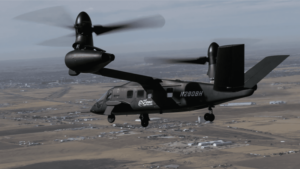The Army’s award to Bell [TXT] for development of the Future Long Range Assault Aircraft (FLRAA) could be worth up to $7 billion if all options are picked up, according to officials, who noted that would include delivery of prototype aircraft and the first lot of low-rate initial production platforms.
Maj Gen. Robert Barrie, the Army’s program executive officer for aviation, said the initial contract awarded to Bell on Monday evening that’s worth up to $1.3 billion does not cover production of physical aircraft, while the deal begins a $232 million order for 19 months of work that will culminate in delivery of virtual prototypes.

“It will allow us to continue with preliminary design and then get to the design, development and delivery of virtual prototypes, essentially a model-based system that we’ll use as we proceed,” Barrie told reporters during a briefing on the FLRAA decision. “There are options that are included in this award that allow for the entirety of the program, through the fielding, to potentially be exercised based on future decisions.”
Bell’s V-280 Valor tiltrotor aircraft was named the winner of the FLRAA program on Monday, beating out a Sikorsky [LMT]-Boeing [BA] team’s Defiant X coaxial rigid rotor helicopter offering for the competition to find a UH-60 Black Hawk helicopter replacement (Defense Daily, Dec. 5).
“This is an exciting time for the U.S. Army, Bell, and Team Valor as we modernize the Army’s aviation capabilities for decades to come,” Bell CEO Mitch Snyder said in a statement following the award announcement. “Bell has a long history supporting Army Aviation and we are ready to equip Soldiers with the speed and range they need to compete and win using the most mature, reliable, and affordable high-performance long-range assault weapon system in the world.”
Army officials declined to offer specifics on factors that led to choosing Bell’s V-280 tiltrotor for FLRAA, while reiterating that the source selection process was focused on achieving best value for the service’s future fleet.
“We’re not going to talk specifics about the evaluation but what we were seeking is the best value approach. So using…the requirements the Army had for it, we then had an evaluation using folks from across the enterprise to go toward a set of factors that would deliver a best value approach to the Army. And that’s how we arrived at this decision,” Barrie said.
Sikorsky and Boeing have not stated whether they plan to protest the award, while issuing a statement on Monday evening that they would “evaluate our next steps.”
“We remain confident Defiant X is the transformational aircraft the U.S. Army requires to accomplish its complex missions today and well into the future. We will evaluate our next steps after reviewing feedback from the Army,” Sikorsky and Boeing said in their statement.
The Army has factored a potential protest of the FLRAA award into its planned program timeline, Doug Bush, the Army’s top acquisition official, told reporters during the briefing.
Barrie noted FLRAA could total $70 billion over the total life of the program, based on the number of aircraft procured and potential foreign military sales, while Bush added that number is not finalized.
The Army said the plan is to have Bell deliver the first physical prototypes for FLRAA in 2025, while Barrie detailed how continued digital design and work on the virtual prototype will further work on the future aircraft in the near-term.
“Embracing model-based system engineering and this digital environment is a cornerstone of this program. So what we wanted to do was leverage the modeling and activity that went into a preliminary design review and be able to use that in the future, both to assess the design itself as well as to assess potentially training and sustainment of the system. So we’re very excited that this early in the program we will have a well-defined and robust digital mode of the system,” Barrie said.
Bell is also competing against Sikorsky for the Army’s Future Attack Reconnaissance Aircraft (FARA) program to find a new scout attack helicopter under the Army’s Future Vertical Lift initiative, with plans to fly the first prototypes next year.